
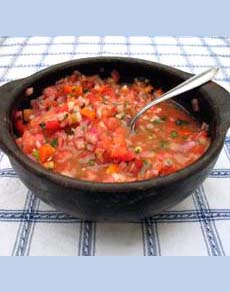 Salsa fresca, a more finely chopped version of salsa cruda. Photo by Marjorie Manicke | SXC.
Salsa fresca, a more finely chopped version of salsa cruda. Photo by Marjorie Manicke | SXC.
April 2007
Last Updated July 2025
|
 |
Salsa Fresca & Other Salsa Types
Salsa Glossary Page 4: Salsa Terms S~Z
|
Here you’ll find the difference between salsa cruda, salsa fresca, and salsa roja, along with a variety of interesting sauces from different parts of South America. This is Page 4 of a four-page article. Click on the black links below to visit other pages. See all of our delicious food glossaries.
|
|
This glossary is protected by copyright and cannot be reproduced in whole or in part.
You are welcome to link to it.
|
SALSA
Pronounced SAL-sah, it’s the Spanish word for sauce of any kind. In the United States, salsa fresca is commonly referred to simply as salsa. However, with a modifier, it can mean any type of sauce—salsa de chocolate, for example, is a chocolate sauce.
|
SALSA CRIOLLA
Salsa Criolla is the most popular condiment in Peru. It is similar to salsa cruda, composed of finely chopped sliced onions, vinegar, tomatoes, garlic, chili peppers, bell peppers, olive oil, salt, pepper, and fresh herbs like parsley or cilantro. While it can be diced like other salsas, in Peru, the ingredients are usually sliced. There are variations in other Latin American cuisines.
|
|

Salsa criolla (photo by Manuel González Olaechea | Wikipedia | License CC by 3.0.
|
|
SALSA BORRACHA
Meaning “drunken salsa,” this Mexican salsa gets its name from the addition of alcohol, typically beer or tequila. The alcohol adds a unique depth and complexity to the flavor profile. Other ingredients include fresh or toasted tomatoes, chiles (arbol or serrano), onion, garlic, and spices.
Here’s a recipe.
|
|

Salsa borracha (photo © Taste Of Home).
|
|
SALSA CRUDA
Pronounced CROO-dah, “raw sauce” or uncooked sauce. Like salsa fresca, it is made with uncooked ingredients: tomatoes, onions, chiles, cilantro, and lime juice (other raw ingredients like bell peppers can be added). The difference in terminology is largely regional, although a salsa cruda is less finely chopped than a salsa fresca.
In the U.S., this style is often called pico de gallo. See also salsa fresca, below.
|
|
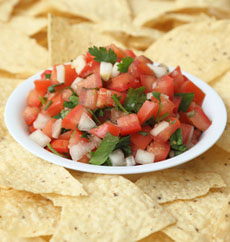
Salsa fresca. Photo © Waymore Awesomer | Fotolia.
|
|
SALSA DE AJI
Like salsa criolla, salsa de aji is a condiment found on every table. It’s made with the Peruvian yellow aji chile and cooking oil, from moderate heat to extremely hot. In addition to meat and fish dishes, it is used as a dip for fried cheese sticks (tequeños), fries, chips, and other foods.
SALSA DE AREQUIPA
Pronounced ah-reh-KEE-pah, a sauce from Arequipa, a city in the Andes Mountains in southern Peru. It is often served with potatoes, which are indigenous to Peru. It is made with aji chiles, shrimp, and hard-boiled eggs. Some recipes add nuts; this one uses cheese: In a large bowl, combine 8 dried yellow aji chiles, seeds and stems removed, soaked in water to soften, and puréed (or substitute 6 New Mexican red chiles); 3 Saltine-type crackers or water crackers, crumbled; ¼ cup ground walnuts; ½ cup grated Monterey Jack, ¼
|
|
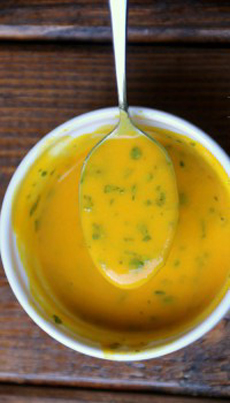
Salsa de aji. Photo courtesy Laylita.com.
|
|
cup vegetable oil; ¼ cup chopped onion; 1 clove mashed garlic; 2 minced hard-boiled eggs; 12 cooked shrimp, peeled and mashed. Mix well into a thick paste. Using a potato masher, drizzle in milk as needed to turn the paste into a thick sauce. Add salt and pepper to taste.
|
|
SALSA DI MANI
Pronounced MAH-nee, a South American peanut sauce. Different countries use different chiles. One version can be made by sautéing 3 tablespoons of minced onion in 3 tablespoons of butter for two minutes; add 1 tablespoon minced seeded jalapeño chile and 1 tomato, peeled, seeded, and coarsely chopped, and cook until the sauce becomes mushy. Then add 1/2 cup chunky peanut butter and mix well. Remove from heat and slowly add up to 4 tablespoons of water for a pourable consistency. Add salt and pepper to taste.
|
|
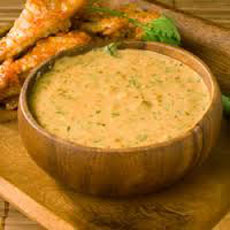
Salsa di mani, a peanut salsa. Photo courtesy Dishbase.com.
|
|
Pronounced FRES-kah, “fresh sauce” in Spanish, referring to the uncooked ingredients. Salsa fresca is what Americans typically refer to as salsa. The main ingredients are tomatoes, chiles, onions, and generally lime juice, although other vegetables can be added. The texture can vary: uncooked salsas can be puréed until smooth, chopped finely (see pico de gallo), or be served semi-chunky, in which case it is called a salsa cruda. See the photo at the top of the page.
The terms salsa cruda (raw salsaA) and salsa fresca are often used interchangeably. They are virtually identical, with subtle distinctions. Fresca emphasizes freshness, while cruda emphasizes that the ingredients are raw/uncooked.
Both refer to a fresh, uncooked salsa made with raw ingredients. The specific preparation (chunky vs. smooth, particular ingredients) will depend more on the individual recipe than on whether it's called cruda or fresca.
SALSA MEXICANA
Pronounced mek-hee-KAH-nah, meaning “Mexican sauce” in Spanish. See pico de gallo.
|
|
SALSA MORITA
Morita is a Mexican salsa made primarily from dried, smoked jalapeno chiles (called moritas) that give it a smoky, slightly sweet flavor—similar to chipotle chiles but with a lighter smoke. The recipe also includes roasted tomatillos, onions, and garlic, with seasonings such as cilantro, spices, and vinegar.
Here’s a recipe.
|
|

Salsa morita (photo © Taste Of Home).
|
|
SALSA ROJA
Pronounced RO-ha, Spanish for “red sauce.” The red color comes from a base of tomatoes. Salsa roja can be fresh or cooked. While tomatoes are not a primary salsa ingredient in most of Mexico, there is some usage in salsas made in northern Mexico. Americanized salsa is a tomato-based product.
SALSA TAQUERA
(tah-KEH-rah): Taco sauce. See taco sauce entry.
|
|
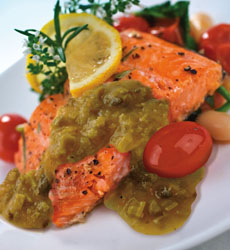
Grilled salmon with salsa verde. Photo courtesy Casa Martine. |
|
SALSA VERDE
Pronounced VAIR-deh, Spanish for “green sauce.” This sauce is made with tomatillos, green chiles (like jalapeños or serranos), onion, garlic, cilantro, and salt. Some recipes include cumin or white onion. It’s a much thinner sauce than a tomato-based salsa roja.
Salsa verde can be fresh or cooked.
|
|

Salsa verde at Empellon in New York City. |
|
SOFRITO or SOFFRITTO
Pronounced soh-FREE-toh, a sauce made by sautéing annatto seeds in rendered pork fat to turn the oil red; the seeds are then removed. Then chopped onions, green peppers, garlic, pork, and various herbs are cooked in the flavored oil until tender. Sofrito is used to flavor soups, sauces, and meat dishes. Italians make a similar mixture, sautéed in olive oil. More about soffrito.
TACO SAUCE
A smooth, thin, pourable sauce made with tomatoes, chiles, vinegar, garlic, and salt.
|
|
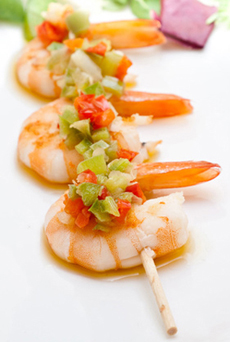
Grilled shrimp with sofrito. Photo © Miunica Neurona | Fotolia. |
|
TOMATILLO
Pronounced toe-ma-TEE-yo (see photo at right). While often called a green tomato, the tomatillo is actually a relative of the gooseberry. It's a tart, green fruit with a papery husk, and is used to make salsa verde.
TOMATO SALSA
Any salsa made with a tomato base, i.e., any red salsa or salsa roja.
Go To The Article Index Above
|
|
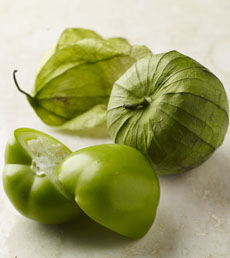
The tomatillo. While it looks like a green tomato, it grows on a bush like the gooseberry, to which it is also related, as can be seen by the papery husk. Photo courtesy McCormick. |
© Copyright 2005-2025 Lifestyle Direct, Inc. All rights reserved. All images are copyrighted to their respective owners.
|











